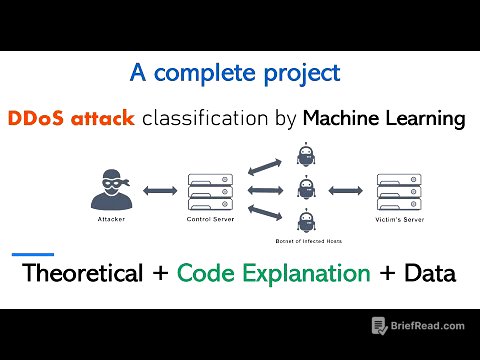TLDR;
This video evaluates and ranks NASDAQ 100 income ETFs based on share price stability, dividend history, dividend treatment (Return of Capital vs. ordinary dividends), and assets under management (AUM). The analysis assumes a $100,000 investment in each ETF on February 13th to compare their performance over six months, considering both dividend payouts and capital preservation. The Goldman Sachs GPIC and NEOS QQQI are highlighted as top performers due to their capital growth and dividend returns, while QYLD is noted as the only one with negative returns.
- Stability of share price is important to preserve capital.
- History of dividend payouts is important to check if it's stable and reliable.
- Return of capital is better than ordinary dividends because it lowers cost basis.
- AUM is important because it tells how much money investors have put into that ETF.
Introduction: Evaluating NASDAQ 100 Income ETFs [0:00]
The video introduces a comparative analysis of NASDAQ 100 income ETFs to determine the best performers. Unlike high-yield ETFs, the focus is specifically on those tracking the NASDAQ 100. The evaluation aims to identify ETFs that offer stable and reliable passive income, moving beyond simple yield calculations to consider factors important for income-focused investors.
Evaluation Metrics for Income ETFs [0:49]
The presenter outlines four key metrics for evaluating the ETFs: stability of share price (capital preservation), history of dividend payouts (stability and reliability), the nature of dividends (Return of Capital (ROC) versus ordinary dividends), and assets under management (AUM). ROC is preferred due to its tax advantages, potentially leading to capital gains tax rates on distributions once the cost basis is reduced to zero. A higher AUM is considered better, indicating greater stability and lower risk of the ETF being delisted. The NASDAQ 100 is highlighted as having higher volatility, leading to richer option premiums and potentially higher dividend payouts compared to S&P 500 ETFs.
NEOS QQQI Analysis [4:17]
The NEOS QQQI, launched in January 2024, is analysed based on a hypothetical $100,000 investment made on February 13th. This investment would have yielded approximately 1,800 shares. Over the past six months, it paid out $6,700 in dividends. The initial investment would have slightly decreased to $99,389, indicating good capital preservation. The total return, including dividends, would be $106,000. The ETF has an AUM of nearly $4 billion, and its distributions are primarily ROC, which is viewed positively.
Roundhill QDATE Analysis [6:06]
The Roundhill QDATE, which debuted in March 2024, is examined using the same $100,000 investment scenario from February 2025. This would have resulted in about 2,480 shares. The ETF distributed $15,000 in dividends over six months. However, the initial investment decreased to $88,000, resulting in a total return of $103,000. The distributions are ROC, and the AUM is $855 million, approaching the $1 billion mark.
Yield Max QDTY Analysis [7:26]
The Yield Max QDTY, launched in February, is assessed with the standard $100,000 investment. This would have bought approximately 1,975 shares. The ETF paid out $12,000 in dividends, with distributions being overwhelmingly ROC (90-92%). The initial investment decreased to $88,895, but the total return was $101,000. The AUM is only $12 million, which is considered a significant concern, although the ETF is relatively new.
JP Morgan Chase's JEPQ Analysis [9:08]
JP Morgan Chase's JEPQ, which has been on the market since 2022, is analysed. A $100,000 investment would have secured 1,720 shares. The ETF distributed $5,471 in dividends over the past six months. The initial investment decreased to $96,028, but the total return was $101,599. The distributions are ordinary dividends, which are taxed at a higher rate. However, the AUM is nearly $30 billion, a very positive factor. QDTY and QDATE pay dividends weekly, while QQQI and JEPQ pay monthly.
Goldman Sachs GPIC Analysis [10:33]
The Goldman Sachs GPIC, launched in 2023, is evaluated. A $100,000 investment would have bought 1,983 shares. The ETF paid out $4,900 in dividends over six months. The initial investment increased to $101,000, showing capital growth. The total return was $106,000. Distributions are mostly ROC, and the AUM is $1.3 billion, both considered positive.
Global X QYLD Analysis [11:49]
Global X QYLD, which has been on the market since 2013, is analysed. A $100,000 investment would have secured 5,333 shares. The ETF paid out $6,180 in dividends. However, the initial investment decreased to $89,000, resulting in a total return of $95,000, the worst performance among the ETFs analysed. The AUM is $8.3 billion, the second largest on the list, and distributions are ROC.
Final Verdict and Investment Strategy [13:54]
If focusing solely on dividend distributions, Roundhill QDATE would be the top pick due to its $15,000 payout over six months, followed by Yield Max's QDTY. However, considering all metrics, NEOS QQQI and Goldman Sachs GPIC are the best overall performers, both yielding a total return of $106,000. Despite NEOS QQQI slightly outperforming GPIC, the presenter prefers Goldman Sachs GPIC due to brand reliability and the management team, aligning with a long-term investment strategy. The presenter hesitates to recommend Global X QYLD due to its negative returns.









